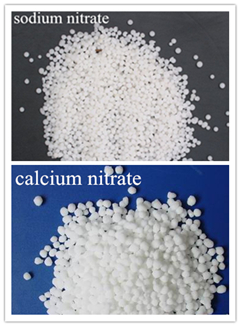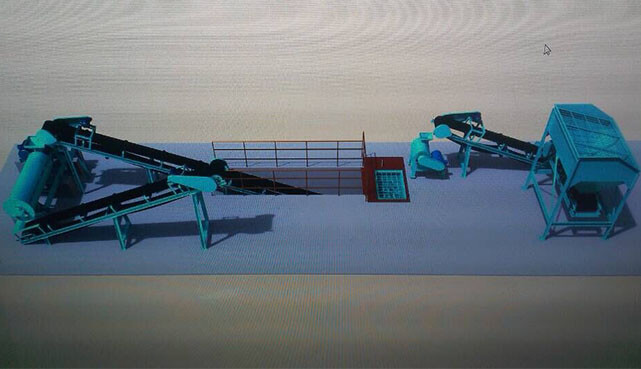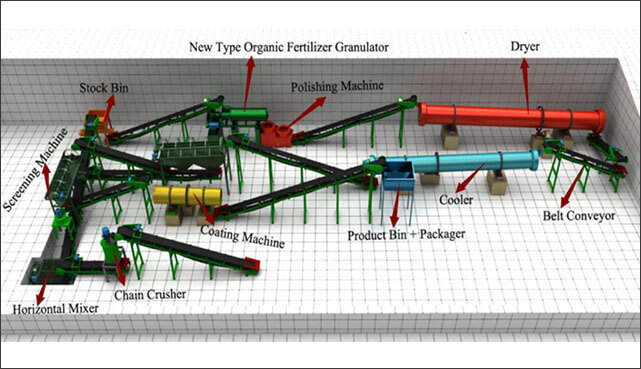Fertilizer is material that is applied to the soil or sprayed on crops aboveground directly or indirectly in order to supply nutrients, increase crop yields and improve product quality. Direct fertilizer supplies essential nutrients to crops, including NPK fertilizer, compound fertilizer and micro-element fertilizer, etc. Indirect fertilizer is used for improving soil physical and chemical properties, thereby making growth condition of crops better, such as lime, gypsum and bacterial fertilizers. Fertilizer is in a variety of classification method and types, while having great difference in ingredient and chemical property. What are different types of fertilizer? How to classify the fertilizer? This question is explained in further detail below.
Inorganic fertilizer
Inorganic fertilizer or chemical fertilizer contains one or more nutrient elements for crops growth, which is made by chemical means. It includes nitrogen fertilizer, phosphate fertilizer, potash fertilizer, micronutrient fertilizer and compound fertilizer, etc. The fertilizer is characterized by simple component, high nutrients and long fatty effect.
Nitrogen fertilizers
Nitrogen fertilizers contain nitrogen that crops need during development. Nitrogen plays a very important role for crops growth, which is part of amino acids in plants and is a component constituting the protein. Meanwhile, it is constituent part of chlorophyll that tips the balance in the process of photosynthesis. Nitrogen can also help crops sub-colonization. Nitrogen fertilizer can not only increase production of agricultural products, but also improve the quality of agricultural products.

Ammonium nitrogen fertilizer contains ammonium bicarbonate (NH4HCO3), ammonium sulfate {(NH4) 2SO4}, ammonium chloride (NH4Cl), ammonia (NH3.H2O), ammonia (NH3) and so on. Ammonium nitrogen is easy to be adsorbed by soil colloids, partially into the clay mineral crystal layer. Ammonium nitrogen becomes nitrate easily by oxidation. Ammonia losses volatilizes in an alkaline environment. When crops absorb excess ammonium calcium, magnesium and potassium, it cuases a certain inhibiting effect. Ammonia has a strong irritating odor, corrosiveness and volatileness. Therefore, it can not be directly used for fertilizing. It is available after configured to dilute ammonia.
☆Ammonium bicarbonate
Ammonium bicarbonate is white compound and crystal in granularity, clintheriform and columnar. Aqueous solution is alkaline. Because of unstable nature, it is decomposing into carbon dioxide, ammonia and water above 36℃.Decomposition is finished at the temperature of 60℃. Nitrogen is used for a variety of soil. It can provide ammonium and carbon dioxide for crops growth. Because of low nitrogen content, it is easy to agglomerate. It not only promotes crop growth and photosynthesis, but also helps crops come into leaf.
☆Ammonium sulfate fertilizer
Ammonium sulfate fertilizer is white orthorhombic crystal, which is soluble in water and insoluble in alcohol. Ammonium sulfate is mainly used as fertilizer in agriculture. The advantage of the fertilizer is relatively small hygroscopicity, not easy to agglomerate. Compared with ammonium nitrate and ammonium bicarbonate. Ammonium sulfate has good physical properties and chemical stability. Ammonium sulfate fertilizer is readily available fertilizer and good biological fertilizer. The reaction in the soil is acidic so that the fertilizer is fit for alkaline soils and carbonaceous soils. The disadvantage is that nitrogen content is low.
☆Ammonium chloride
Ammonium chloride is white crystal or colorless crystal powder. Hygroscopicity is small, but it can absorb moisture being caking in wet rainy weather. Powdered ammonium chloride is easily deliquescent, qualified products even worse. Moisture absorption point is generally about 76%. Therefore, the fertilizer should be kept in dry place. It can be used as fertilizer. Avoid using ammonia fertilizer with alkaline fertilizer. It is better not to apply the fertilizer in saline-alkali soil as it may reduce fertility.
2.Nitrate nitrogen fertilizer
Nitrate nitrogen fertilizer includes nitrate fertilizer sodium nitrate (NaNO3), calcium nitrate {Ca (NO3) 2} and ammonium nitrate (NH4NO3), etc. Nitrate nitrogen dissolve easily in water and moves fast in soil. It not only promotes cation absorption, but also facilitates the synthesis of organic anion. For instance, corn and wheat prefer nitrate nitrogen fertilizer. Under the condition of equal nitrogen amount, yield-increasing effect of nitrate nitrogen fertilizer is more prominent than other nitrogen fertilizers. Vegetables have strong preference for nitrate nitrogen. In hydroponic experiment, as long as the nutrient solution is added nitrate, vegetables grow normally without ammonium or urea nitrogen. Simultaneously, tobacco responds to nitrate well. Applying nitrate nitrogen fertilizer increases output of tobacco and improves its quality.

Sodium nitrate is colorless transparent or white rhombohedral crystal. It is easy to deliquescent. Under the condition of small amounts of sodium chloride with impurities, deliquescence of sodium nitrate would greatly increase. Sodium nitrate helps combust, so it should be stored in a cool well ventilated place. It is used as readily available fertilizer, especially pertinent in beets, radishes and so on.
☆Calcium nitrate
Calcium nitrate is a typical fast-acting foliar fertilizer. It can successfully act on acidic soil because calcium can neutralize soil acidity. It is convenient for regeneration fertilizing of winter crops, additional fertilization and excessive consumption of alfalfa growth. In addition, it is widely used for sugar beet, fodder beet, poppy and corn, supplying calcium for crops.
3.Amide nitrogen fertilizer
Urea, also known as carbamide, is a white crystal and one of the simplest organic compounds. The nitrogen content of urea is 46%, which is the highest in solid nitrogen fertilizer. It is the final product of protein metabolism in mammals and some fish. As a neutral fertilizer, urea is suitable for a variety of soil and plants. It is easy to save and use. Because of small destructive effect to soil, it is the chemical fertilizer with heavy usage. Urea is the most common nitrogen fertilizer. Urea is suitable for all crops and soils, which is used for base fertilizer and additional fertilizer.
Urea is used as base fertilizer and topdressing, sometimes as seed fertilizer. Under normal circumstances, urea conversion needs 7-10 days at the temperature of 10℃,4-5 days at 20℃, and only two days at 30℃. When urea is converted to ammonium in the soil, it can be absorbed by seedlings in quantity. Therefore, the utility of urea fertilizer should be a few days earlier than the other administration.
Phosphorus fertilizer
Phosphorus is the the main nutrient in phosphorus fertilizer. Fertilizer efficiency depends on effective phosphorus pentoxide content, soil properties, fertilizing method and crop strains, etc. Phosphorus is a component of the cell protoplasm in plants. It plays an important role in cell growth and proliferation. Phosphorus is also involved in photosynthesis, the use of sugar and starch and energy transfer. Phosphate fertilizer also promotes the growth of plant root systems, making the plant ripe early. In the fruit stage, massive phosphorus transfers to the grain, making seed full.
1.Water soluble phosphorous fertilizer
This kind of fertilizer is soluble in water, having high fertilizer efficiency.
The main products are calcium superphosphate and triple superphosphate.

Calcium superphosphate, also called ordinary superphosphate, is obtained by decomposing phosphate rock with sulfuric acid. Calcium phosphate contains effective 14% ~ 20% P2O5(of which 80% to 95% soluble in water), being a part of water-soluble phosphorous fertilizer. It is gray or white powder (or particles), which can be used as phosphatic fertilizer directly or compound fertilizer ingredients. To mix with nitrogen fertilizer is conductive to nitrogen fixation, reducing nitrogen loss.
☆Triple superphosphate
Triple superphosphate is small granular solids, slightly acidic, which has gray or dark brown colour in appearance. It is suitable for long-distance transport and storage. It is soluble in hydrochloric acid, nitric acid and water, practically insoluble in ethanol. Triple superphosphate fertilizer is suitable for a variety of soil and crops. It can be used as base fertilizer, topdressing and compound (mixed) fertilizer. It is widely used in rice, wheat, corn, sorghum, cotton, fruits and vegetables, etc.
2.Mixing soluble phosphate fertilizer
Nitrophosphate is the fertilizer that obtained by decomposition nitric acid, while N/P ratio is 2:1. The use of the fertilizer can supply trace elements in the soil. It can also significantly improve the quality of agricultural products. Nitrophosphate applies not only to wheat, corn, rice and other food crops, but also for rape, tea, cotton, garlic, banana, litchi, apple, watermelon, grapes and other industrial crops. It should be deep placement, casingsoil, deep application of base fertilizer, to avoid contacting with the seeds or roots directly. It is generally used as base fertilizer for common field crops and top application for industrial crops. It is better to apply frequent, small amounts of fertilizer, which aims to improve the utilization of fertilizer.
3.Citrate-soluble phosphatic fertilizer
This kind of fertilizer is insoluble in water. It mainly contains precipitated phosphate, steel slag phosphate fertilizer, calcium magnesium phosphate and defluorinated phosphate fertilizer. Generally, it is applicable to the acidic soil, so it should be used for base fertilizer. It can be dissolved by organic acids that are secreted by soil and plant roots , and then it is gradually absorbed by crops.
Potassium fertilizer
Potassium is the primary nutrient in potash fertilizer. Potassium in plants usually accounts for 0.2% ~ 4.1% of dry matter, second only to nitrogen. In plant growth and development, potassium is involved in the activation of more than 60 kinds of enzymes, photosynthesis, assimilate transportation, carbohydrate metabolism and protein synthesis.
1.Muriate of potash
Potassium chloride is chemically neutral and fast-acting fertilizer, which is well suited for rice, wheat, cotton, corn, sorghum and other field crops. Because of physiological acidity, potassium can be used in neutral calcareous soils. It can be used as base fertilizer or topdressing. Because potassium chloride fertilizer contains a large amounts of chloride, it will affect the growth of seed germination and seedling.
When it is used as base fertilizer, it should be applied to arable soil 10-15 days before sowing. It should be used early in order to leach chlorine ion to lower soil by rain or irrigation water, removing or reducing damage to crops.
2.Potassium sulphate
Potassium sulphate is one kind of potash fertilizer. Potassium sulphate consumption is far less than potassium chloride, which is less than 10% in international potash fertilizer market. It is suitable for a variety of crops, especially for tobacco, sugarcane, potato, sweet potato, grapes, tea and cruciferous crops (such as rape, beans, etc.). It is generally used for dry land rather than paddy field.
Organic fertilizer is commonly known as farmyard manure or natural fertilizer, mainly from animals and plants. When it is applied to soil, it can supply carbonic materials for plants growth. It includes a variety of organic acid and rich nutrient elements. It not only provides complete balance of nutrients, but also has high manurial effect. Organic fertilizer can increase the content of organic matter, promote microorganism reproduction and change soil physical and chemical properties. Therefore, it is the main nutrient for green food.
1.Agricultural waste
Some agricultural wastes are good materials for organic fertilizer, such as straws, bean pulp, and cottonseed meal and so on. The wastes play an unique role in increasing soil nutrient and improving soil structure.
The main manure ways are used directly to field. The technology is simple to operate, while saving time and labor. Related experiments have shown that the soil porosity increases 2.1% to 4.1% after straw using to field for 2 to 3 years, organic material increasing 0.5 ~ 1.7g / kg, rapidly available potassium increasing 15.0 ~ 18.7mg / kg.
2.Livestock manure
These materials include pig manure, chicken manure and rabbit manure, etc. Livestock manure is one of natural fertilizer in agriculture.see more at: Chicken Manure Fertilizer Granulation Technology
Untreated livestock manure contains hazardous substance, such as escherichia coli, nematode and eggs. The application of untreated excrement rises temperature after fermentation, causing seedling burnt. To improve efficiency and reduce harm to crops and the environment, animal dung should be applied to field after complete composting.
3.Industrial waste
Some industrial waste are good materials for organic fertilizer, such as distilers’ grains, vinegar residue and sugar-free grains. On the one hand, the use of wastes in agriculture increases resource utilization rate and reduces environment pollution. On the other hand, it reduces the burden on industry and changes waste material into things of value.
4.Municipal sludge
Because of growing sewage treatment works, the production of municipal sludge is increasing year by year. Many people pay more attention to how to use it reasonably. Applying municipal sludge into agriculture is a good choice for urban construction.
River muck and sewage can be made into organic fertilizer. Because of complete component of the sludge, it just meets the requirements of nutrients in plants growth. Therefore, processed sludge can be used as fertilizer. It contributes to soil amelioration as well as reducing pollution. Not only solving the problem of waste treatment, but also is good for plants growth.






